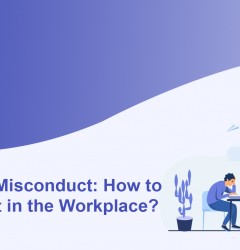26 Oct

Did you know? The U.S. Bureau of Labor Statistics (BLS) study says that HR manager roles will expand at a 9% annual pace until 2030, which is better than the national global average.
If you enjoy communicating with people and are enthusiastic about fairness and equal working conditions, you might well have thought about working in human resources (HR).
Human resource professionals, maybe more than almost any other function, have the ability to define business culture and determine policy in organizations. However, with great power comes great responsibility.
HR experts often play a significant role in determining how a company operates, impacting everything from corporate culture to how the corporation retains personnel and accomplishes long-term goals.
Suppose you’re interested in where to get started in human resources. In that case, this blog will help you explore responsibilities in the HR career path and suggest a plan for planning your journey up the human resources hierarchy.
Table of Contents
What Precisely is Human Resources?
Human resources (HR) is a department that is solely responsible for managing an organization’s most important asset: its employees. The department collaborates with managers and executives to contribute to something and direct the employees in order for the company to realize its strategic objectives.
As the relevance of the idea of employee engagement has grown, HR has assumed a more purposeful responsibility for guaranteeing that employees have a pleasant experience in the context of both physical and mental health, as well as workplace technologies and specific locations.
What is the HR Career Path?
The HR career path involves all human resource roles. An HR department is in charge of hiring and managing employees on an organizational rather than a departmental level.
HR teams are not directly accountable for employee performance, but they could also try to increase organizational effectiveness by introducing organization-wide policies designed to enhance organizational efficiency and morale. They also coordinate new employee recruiting and onboarding, as well as payroll, compensatory damages, and benefits.
HR managers might also be responsible for dealing with official workplace grievances. Before commencing their profession in an entry-level HR position, the majority of HR professionals have an undergraduate degree.
As an HR professional, you can work exclusively in HR within a particular sector, especially if you have technical talents that allow you to provide a greater degree of expertise in some of these disciplines than other HR professionals. HR professions are available at all levels, with more leadership levels in HR being the HR Director and Chief HR Officer (CHRO).
How does A Human Resources Career Path Benefit You?
People have frequent misunderstandings that the HR department’s work is simple. That, meanwhile, is not the case. When it comes to the massive number of responsibilities involved with HR roles, the list is nearly endless.
HR professionals can deal with labor relations, employment legislation, recruitment, employee compensation, development programs, business culture, human capital deployment, performance management, and a variety of other responsibilities.
However, like with many departments, these responsibilities are assigned among a number of human resources professionals, generalists, and other jobs.
While HR professions are definitely rewarding and demanding, they are also quite simple to enter. You can work in human resources even if you have a Bachelor’s degree in business administration. You could further your career by earning a Master’s degree in human resources and aiming for higher-level roles.
Even if you are not already working in the HR sector, you can pursue a lateral shift into the industry if your firm allows it. You’ll most certainly start at the bottom of the HR job ladder, but it is possible to work your way up.
Someone might argue that a simple job shift would eventually lead to the popularity of HR professionals. However, a study predicts that the number of HR professionals will increase by 7% by 2026. Similarly, over the same time period, the number of human resource managers is predicted to rise by 9%.
HR roles cannot be automated since it is a business, first and foremost. This means that the demand for HR professionals will always be higher than the supply of HR officers.
The HR Career Path You Should take in Human Resources
When it comes to identifying the best HR career path for you, there is no other approach. The hr career path you pursue will be determined by your objectives, interests, and talents, which explains that what is good for you may be very distinguishable from what is appropriate for another HR professional, even if you attempt from the same place and possess the same degree of experience.
Having said that, there are, nonetheless, rules you should follow in choosing the best option for you. Your starting point is your ideal job. “What is my dream job?” you should ask yourself. If you already know whatever you want, all that remains is to determine the abilities, talents, and experiences you’ll need to acquire in order to get there. Following that, it’s a matter of charting your development.
With so many HR positions available and so many diverse abilities necessary for each, this may be a difficult process. That is why we have developed a framework to assist you in determining what talents you need to learn and which positions will help you go where you want to go.
This framework gives you a clear grasp of the many combinations of behaviors and abilities required to succeed in various HR professions, which are classified as follows:
- Functional capabilities. specific to the area of HR in which you specialize, such as Compensation and Benefits or Learning and Development — as well as role-related abilities, such as project management, communication, and marketing
- Behaviors and Skills. Business acumen, digital dexterity, data literacy, and people advocacy competencies are skills and behaviors that relate to the four core competencies described above.
There are numerous amounts of HR specialties available, which signifies you should indeed master hundreds of skilled laborers and role-related abilities. Fortunately, most HR jobs can be classified into four types depending on the primary function they provide inside the organization: Advisory, Strategist, Service Provider, and System Integrator. This demonstrates that jobs with the same essential function maintain the same set of basic behaviors and abilities.
- The Service Provider
This profile includes responsibilities at the junior and middle management levels within Combined Services centers.
- The Strategist profile
This profile includes positions that encompass many areas or lines of business, such as local Human Resource professionals and global Core team leadership teams.
- The Advisory Profile
Local HR Business Partners, Consultants, and International HRBPs are examples of positions in the Advisory profile.
- The System Integrators profile
This profile comprises jobs in International Centers of Excellence and local Training & Development teams.
To be capable of switching between different positions, whether inside a profile either between profiles, you should first understand what behaviours and abilities you should always develop.
Examples of HR Career Path Options
To assist you in structuring your own career development, we have provided many HR career path examples that you might follow to advance either vertically or horizontally. A vertical move is a professional development in which you advance one level. A horizontal move, on the other hand, is when you move to a new job (or a functional profile) on the same level as your existing role. To determine your career prospects, begin with the functional profile of your present employment.
1. Human Resources Coordinator
Human Resources coordinators, often known as recruiters, are primarily involved in the recruiting process. Their responsibilities include assisting the HR department with recruiting, payroll management, personnel records, and management services.
Human Resources coordinators are required to find people, set up interviews, verify application references, keep records, and lead orientation sessions.
Human Resources coordinators are typically delegated Human Resources assistant or HRHuman Resources expert roles in Small and medium enterprises.
The standard salary for a Human Resources Coordinator is $45,000, although this figure may rise to $60,000.
2. Human Resources Assistant
The Human Resources assistant or Human Resources officer is entry-level employment that often requires a bachelor’s degree, although not particularly in an area connected to human resources. The Human Resources assistant’s role is to assist with different Human Resources processes. Completing administrative paperwork for new hiring, arranging benefit packages, terminating employees, and other assigned chores are examples of this.
Human Resources assistants are also responsible for the charge of resolving typical work-related difficulties such as attendance, salaries, overtime, and other similar issues. They might also be responsible for sending messages, and reminders, planning workplace events, employment verification, and other duties.
HR assistants earn an annual salary of an average of $35,000. Some employers will reimburse it up to $47,000 per year, although educational and qualification requirements may indeed be demanding.
3. Human Resource Professional
When you reach the Human resource specialist level, you have formally specialized in human resources. This is the stage at which you begin to concentrate on a single Human resource function. You might work as an HR clerk, payroll professional, development and training administrator, or personnel management manager, for example.
Your various skill sets come into play at this time. Benefits, development, employment, and payroll are just a few examples.
In addition to your professional duties, you may be asked to assist with everyday HR operations and other organizational activities.
At this time, you should have a bachelor’s degree and three years of experience in human resources.
The average income for a human resources professional is roughly $50,000. Before reaching the rank of Human Resource generalist, larger businesses elevate Human resource experts to senior HR specialists. Senior human resources professionals can make up to $65,000 per year.
4. Human Resources Generalist
A Human resource generalist might well be thought of as a training job for a Human resource manager. Rather than employing a manager directly, companies typically hire a Human resources generalist and elevate them to a Human resource manager.
Human Resources generalists are in charge of almost everything: recruitment, development, benefits, payments, accountability, and a variety of other tasks.
The qualifications for becoming a Human Resources generalist are comparable to those for becoming a Human Resources expert. However, the typical Human Resources generalist’s income is $51,000, with the possibility of increasing to $68,000 if promoted to senior Human Resources generalist.
5. Human Resources Manager
Human Resources managers are in charge of overseeing processes, rules, and comprehensive reviews. They need to verify that all actions are in agreement with local, national, and federal legislation and that all aspects of human resources (including maternity leaves, holiday leave, flexible work programs, and insurance programs, among others) follow the rules.
The Human Resources manager is also involved in business planning and budget preparation, as well as being in charge of Human Resources strategies throughout an organization.
Managers would have to have problem-solving and communication skills, as well as knowledge of human resource information systems.
A Bachelor’s degree is required for the position, and five years of experience is recommended. The average income for an HR manager is $75,000, with top HR managers earning up to $90,000 per year.
6. Human Resources Administrator
The Human Resources director position could include a variety of responsibilities, such as overseeing many departments or simply supervising the Human Resources managers.
Human Resources administrators are required to work as strategic partners to all employees in the organization, and they are frequently faced with day-to-day challenges and complaints about Human Resources operations.
They also might be required to deal with environmental and legal issues.
They also might be expected to participate in orientation, recruiting, and team-building events.
This profession typically demands a master’s degree and more than ten years of professional experience. The standard Human Resources administrator income is roughly $82,000, with senior HR administrators earning up to $100,000.
7. Vice President, Training & Development Relations/People Operations
The Vice President job is typically seen in organizations that have a specialized executive personnel area. In all other organizations, the post after the HR director is simply known as the CHRO.
VPs of the Human resource departments often have just responsibilities and duties. They frequently make critical choices and are in charge of granting the ultimate approval for any new project, technique, or technique.
In big multinationals, the Vice President job may be referred to as the Vice President of Training & development Relations or the Vice President of People Operations. Generally, it’s simply semantics, but large organizations prefer to separate the responsibilities.
A Vice President of Human Resource’s standard salary is $125,000, with senior vice presidents of HR earning up to $190,000 per year.
8. Chief Human Resources Officer (CHRO)
The human resources career path reaches all the way up to the post of chief human resources officer, which is the supreme authority you might have had. It is mainly administrative in nature. The CHRO communicates with the CEO and other management and executive professionals.
They are in charge of overseeing all Human resources administration for an organization and can recommend changes to top management, create objectives, and check to see if a company is following legislation.
CHROs are also concerned with employee retention and staff development, and they might be in charge of designing Human Resources programs to teach lower-level Human Resources personnel.
Here are Some Tips to Help You Succeed on the HR Career Path
If the abovementioned tasks and responsibilities seem appealing and you would like to begin exploring a career in human resource management, keep these tips in mind.
1. Consider Yourself A Thinking Leader.
Sharing your opinions and experiences with your coworkers can be daunting and sometimes risky—especially when you’re just starting out. Moreover, doing this will help you make new contacts, learn from the accomplishments of others, and identify yourself in the field.
2. Be True to Yourself.
Nearly every day, your colleagues contribute their different viewpoints, from their interests, objectives, and aspirations to their professions. Human resources professionals should follow this example. Showing your colleagues the person behind the job position will help you become a more easygoing and empathic leader.
3. Bring the “Humans” Back into Human Resources.
Human resources involve more than simply achieving sustainable competitive advantage. It’s getting to know the employees who will be affected by the procedures and guidelines you implement. Make time to wander around the organization and encounter staff in person.
What are their passions? What are the upcoming projects they are working on? What would facilitate their work? You might not be able to answer every demand or issue, but you will have a deeper understanding of your staff that extends even beyond corporate salary or databases.
4. Be An Expert.
Whatever human resources professional path you pick, it is always beneficial to comprehend and have knowledge of the duties of each function. This knowledge provides you with a complete picture of how the organization operates (and can help you identify where else you might want to specialize down the line).

Wrapping It Up
From expanding job vacancies to the potential digitalization of many industries, we live in an unpredictable and disruptive environment. As a Human Resources professional, you need to have a diverse range of abilities to be able to transform current and future obstacles into opportunities for yourself.
In this blog, we discussed the HR functional profiles and the many HR career paths available. Each position demands a unique set of fundamental and functional abilities, which are separated into skills and behaviors.
Frequently Asked Questions (FAQ’s)
1. What characteristics distinguish the finest human resource managers?
A human resource manager must be compassionate, capable of making judgments, patient, and possess great communication abilities. They will also be required to obey local labor regulations.
2. Is human resources a sustainable career option?
You desire a profession that is rapidly expanding. Because human resources play such an important part in keeping businesses running efficiently, it’s no surprise that it’s one of the fastest-growing areas in all the countries.












Himani